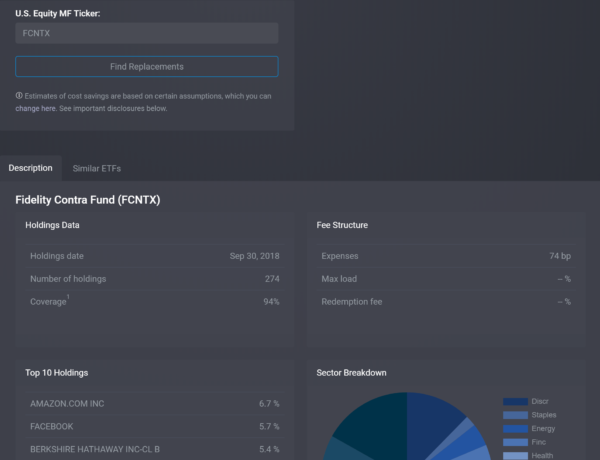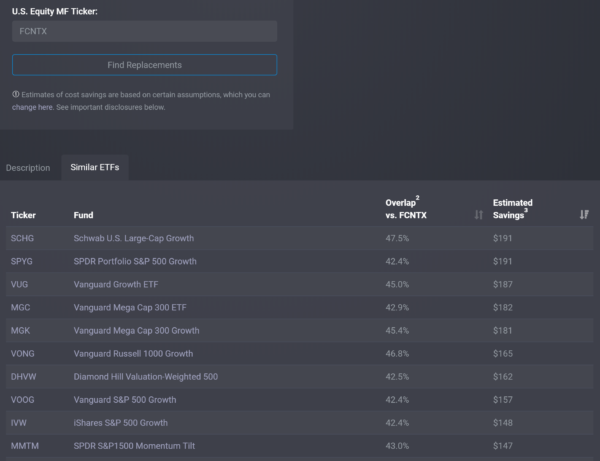
Change Isn’t Always Easy
Millions of investors know that ETFs are often cheaper and more tax-efficient than traditional mutual funds, among other advantages. This awareness has helped ETFs gain market share over the past decade and a half as investors gradually shifted assets out of mutual funds and into ETFs.
There is plenty of room for that trend to continue. According to the Investment Company Institute, assets invested in U.S. equity ETFs exceeded $2.1 trillion as of November 2018. Yet that is still less than one-third of the $7.5 trillion invested in U.S. equity-focused mutual funds.
While many investors understand why they might want to switch from a mutual fund into an ETF, doing so can be easier said than done. We count over 2,400 mutual funds and 660 ETFs in the U.S. equity category. How does an investor know which ETFs are the most suitable replacements for an existing mutual fund portfolio?
Finding Similar ETFs Based on Overlap
The Mutual Fund Replacement Tool helps investors save by utilizing similar low-cost ETFs instead
Our new Mutual Fund Replacement Tool is designed to help investors save money by utilizing similar low-cost ETFs instead. Through our partnership with Neural Finance we have obtained the holdings of U.S. equity mutual funds, as per each fund’s quarterly disclosure filings. Our database then cross-references each mutual fund’s holdings with our ETF holdings data to locate the 20 ETFS with the most overlap by weight. We then calculate potential savings from making the switch into any of these 20 ETFs (more on these calculations below).
Start your search by going to the Mutual Fund Replacement Tool. Enter the ticker symbol of a U.S. equity mutual fund and hit ‘Find Replacements.’ The tool will respond with information displayed across two tabs. The Description tab has some basic information about the mutual fund, including its fee structure, top holdings and sector allocation. It also shows a figure called Coverage. This indicates the percentage of a fund’s holdings by weight which we were able to match to a security in our database.
The next tab is Similar ETFs containing a list of the 20 ETFs with the most overlap by weight, and showing the potential savings to be had from each.
Screenshots
Adding Up the Savings
Calculating potential savings isn’t as straight forward as it may first appear. There is the difference in expense ratios, of course, but the dollar value of those savings depends on the amount of capital and length of time invested. The tool’s default settings are $10,000 and three years, respectively, but you can specify other values by finding the link to ‘change assumptions’.
In addition, there are also trading costs associated with an ETF that mutual fund investors typically don’t need to worry about:
- Commissions. A commission is usually required to buy and sell an ETF unless it happens be on a list of no-commission ETFs that some brokers offer. The Mutual Fund Replacement Tool has a default commission set at $7.95, but you can specify another amount. The tool assumes that your mutual fund can be redeemed commission-free, but that isn’t always the case so be sure to check with your broker.
- Bid/Ask Spread. While mutual funds trade hands at Net Asset Value, ETFs trade with a bid/ask spread. This is an often overlooked but very real cost of trading an ETF. We use an ETF’s average bid/ask spread over the past month in our calculations. Whether frequent trading overwhelms any savings from lower expenses depends on the amounts and holding period entered above.
There may be other costs to consider—mutual fund redemption fees (if any) and tax implications for example—as well as non-cost considerations, such as the mutual fund manager’s track record and skill (if any) in beating index investments like ETFs. That can get complicated, and for some investors keeping the mutual funds they’ve already got might be the best choice.
But for the millions of investors who’ve decided to join the migration to ETFs, our Mutual Fund Replacement tool can help ease the selection process. Once you have the list of potential replacements you can sort by overlap or estimated savings, and then click on the ETF itself for a more detailed look.




